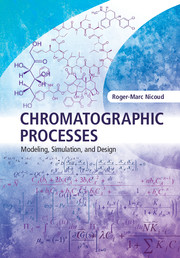Book contents
- Frontmatter
- Contents
- Preface and acknowledgments
- 1 Our approach to modeling chromatographic processes
- 2 Linear chromatography: the Russian Lego
- 3 Non-linear chromatography: equilibrium theory
- 4 Fluid–solid phase equilibria
- 5 Mass transfer
- 6 Hydrodynamics of chromatographic columns
- 7 Simulating chromatographic columns
- 8 Counter-current systems
- 9 Chromatographic modes and their optimization
- 10 Addressing a few industrial problems
- 11 Conclusion
- Appendix A Some important properties of the Laplace transform
- Appendix B Inlet and outlet boundary conditions
- Appendix C Equilibrium theory: single-solute chromatograms
- Appendix D Equilibrium theory: binary chromatograms
- Appendix E The influence of the porosity determination on chromatographic modeling
- Appendix F Useful physico-chemical data and orders of magnitude
- Appendix G Fick and Maxwell–Stefan approaches to diffusion
- Appendix H Non-linear LDF for multi-solute systems
- Appendix I Situations that make the use of the MC model problematic
- Appendix J Typical industrial chromatographic processes
- Notation
- Index
- References
7 - Simulating chromatographic columns
Published online by Cambridge University Press: 05 April 2015
- Frontmatter
- Contents
- Preface and acknowledgments
- 1 Our approach to modeling chromatographic processes
- 2 Linear chromatography: the Russian Lego
- 3 Non-linear chromatography: equilibrium theory
- 4 Fluid–solid phase equilibria
- 5 Mass transfer
- 6 Hydrodynamics of chromatographic columns
- 7 Simulating chromatographic columns
- 8 Counter-current systems
- 9 Chromatographic modes and their optimization
- 10 Addressing a few industrial problems
- 11 Conclusion
- Appendix A Some important properties of the Laplace transform
- Appendix B Inlet and outlet boundary conditions
- Appendix C Equilibrium theory: single-solute chromatograms
- Appendix D Equilibrium theory: binary chromatograms
- Appendix E The influence of the porosity determination on chromatographic modeling
- Appendix F Useful physico-chemical data and orders of magnitude
- Appendix G Fick and Maxwell–Stefan approaches to diffusion
- Appendix H Non-linear LDF for multi-solute systems
- Appendix I Situations that make the use of the MC model problematic
- Appendix J Typical industrial chromatographic processes
- Notation
- Index
- References
Summary
The art of adapting complexity to needs, or the art of modeling the elephant.
Introduction
As stated in previous chapters, the behavior of chromatographic columns is governed by:
• thermodynamic factors, describing the interactions of the solutes and carrier fluid components with the chromatographic medium at equilibrium, as well as possible equilibria in the fluid phase or solid phase
• kinetic factors, describing how fast solutes move in the fluid and solid phases to reach an equilibrium state from a non-equilibrium state
• hydrodynamic factors, describing how the fluid flows into the column.
We generally assume that these factors can be modeled independently of each other, with coupling occurring only at interfaces. This is a very useful postulate, which is the basis of classical chromatography modeling. From a theoretical standpoint, however, it might be subject to discussion: for highly porous particles, the distinction between hydrodynamics and internal transport occurring partially through convection is somewhat vague. In the case of gas adsorption, the adsorption of solutes on the solid may lead to hydrodynamic perturbations. This effect, called the sorption effect, has been described by (Valentin, 1981) and (Le Van et al., 1988). We will consider that these refinements are not required for our purposes, and, except as specified in Section 7.8, we will assume that the decoupling postulate applies between the above factors.
In the past decades, a lot of different more or less refined models have been proposed, and it is out of the scope of this book to review them all. Let us express that the different possible models differ by their representation of hydrodynamic, kinetic or thermodynamic contributions.
The simplest model 2 is the equilibrium model (PF–Equil in our terminology), which assumes plug flow without hydrodynamic dispersion and infinitely fast mass transfer, so that the moving fluid and lumped solid concentrations are in equilibrium. Presented in Chapter 3, this model can be used as a reference as it gives the average position of the fronts, which is independent of hydrodynamic dispersion and mass transfer limitations.
- Type
- Chapter
- Information
- Chromatographic ProcessesModeling, Simulation, and Design, pp. 388 - 437Publisher: Cambridge University PressPrint publication year: 2015

